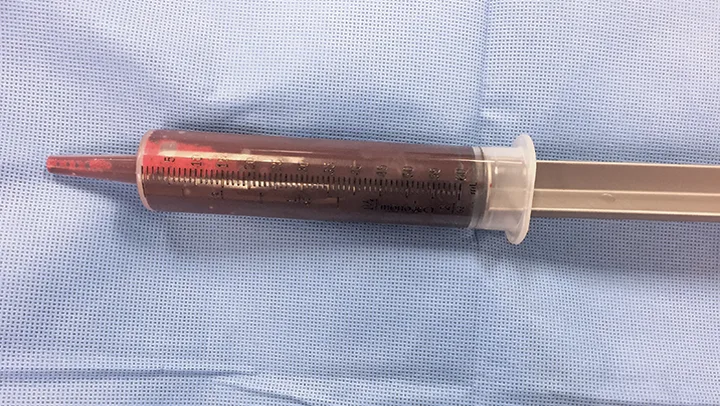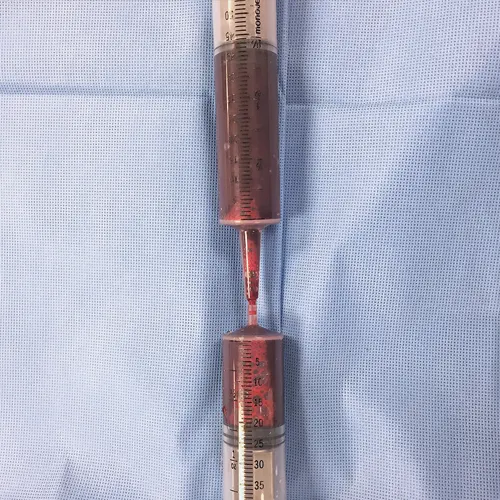Emergency Autotransfusion
Adesola Odunayo, DVM, MS, DACVECC, University of Florida
In the Literature
Robinson DA, Kiefer K, Bassett R, Quandt J. Autotransfusion in dogs using a 2-syringe technique. J Vet Emerg Crit Care (San Antonio). 2016; 26(6):766-774.
The Research …
Autotransfusion is a life-saving, cost-effective practice.1 It uses the patient’s own blood and reduces the risk for transfusion reactions. It is also handy when blood products are unavailable. Dogs may present with intra-abdominal hemorrhage from various causes, including trauma, coagulopathy, surgical complications, or neoplastic masses. These dogs may require RBC transfusion, but blood products may be limited or unavailable. This study described autotransfusion practices in 4 dogs with severe intra-abdominal hemorrhage.

A 60-mL catheter-tip syringe is used to withdraw blood from the abdominal cavity. The catheter tip will allow for faster blood removal.

The obtained blood is transferred from the catheter-tip syringe to the Luer-lock syringe.
In all 4 cases, the dogs were presented in hypovolemic shock as a result of intra-abdominal bleeding. Reasons for the intra-abdominal hemorrhage included 2 dogs with postoperative bleeding from the pedicles/uterine stump after ovariohysterectomy, one dog with postoperative bleeding after ovariohysterectomy/elective gastropexy, and one dog with traumatic hemoabdomen subsequent to falling from a high-rise building.
Dogs were resuscitated with IV fluids before exploratory surgery. In surgery, all dogs received autotransfusion of the intra-abdominal blood using a 2-syringe technique. The blood in the abdomen was aseptically collected with a 60-mL catheter- tip syringe and aseptically transferred to a 60-mL Luer-tip syringe. A 170-µm blood filter was then attached to the Luer-tip syringe, and the blood was rapidly adminstered IV. All dogs made uneventful recoveries and were discharged.
… The Takeaways
Key pearls to put into practice:
Autotransfusion can be performed intraoperatively, as described in this study, but can also be performed in animals with hemothorax/hemoabdomen via centesis.2
The best candidates for autotransfusion are dogs with coagulopathy (ideally performed after coagulopathy is corrected with fresh-frozen plasma administration), trauma, or postoperative hemorrhage. Autotransfusion of neoplastic effusion may potentially lead to disseminating neoplastic cells throughout the body.3 Autotransfusion of grossly contaminated blood (eg, with urine, fecal matter, bacteria, purulent material, or bile) should not be performed.
During autotransfusion, recovered blood may be administered as quickly as possible, especially if the patient is unstable. An anticoagulant is not generally required if the blood has been in the cavity for at least an hour, although one may be considered if there is active hemorrhage.2 A blood filter (20-250 µm) should be used to ensure blood clots are not transfused into the patient. The blood filter should be changed often—after every 30-360 mL, depending on the size of the filter. Any volume that can be salvaged should be given back to the patient.4